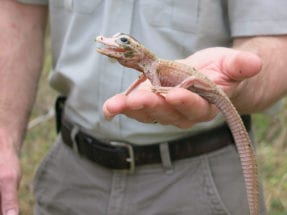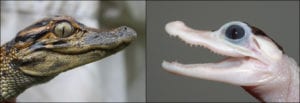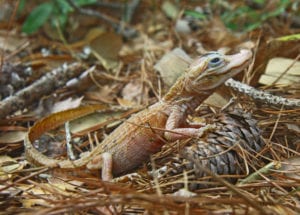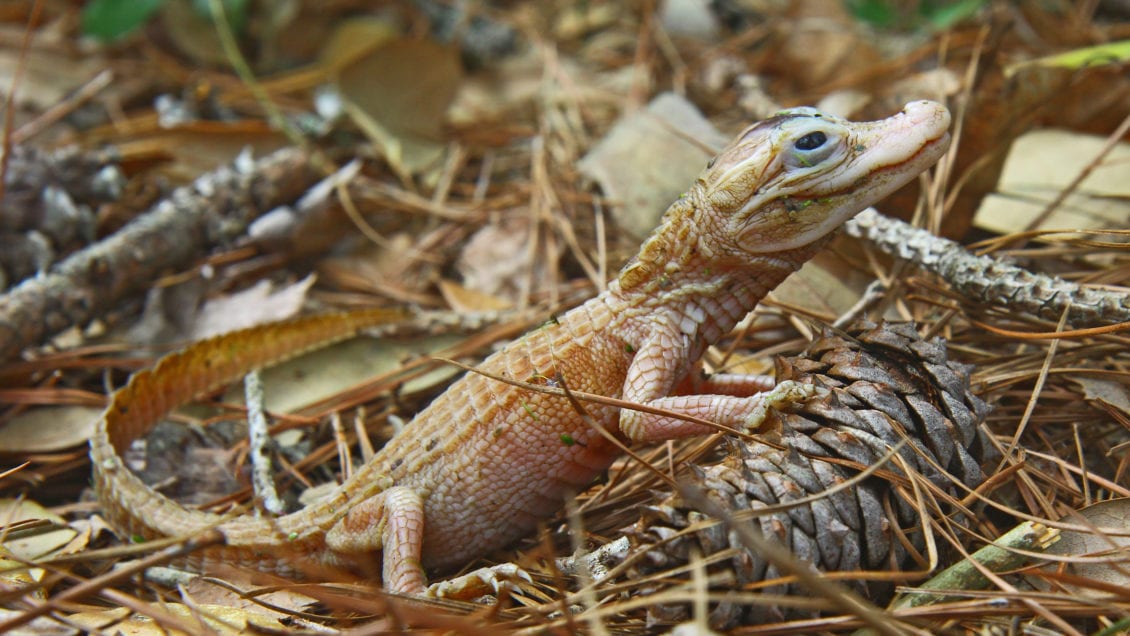An article published in the journal “Southeastern Naturalist” by a Clemson University research scientist and others details the extraordinary finding of six leucistic American alligator hatchlings in Lowcountry South Carolina in 2014, believed to be the most detailed account of such a discovery to date.
Leucism — which manifests in wildlife as white skin and dark eyes — is a rare color disorder occurring in a range of invertebrates and vertebrates, and as a result, few reports exist of leucistic individuals in the wild.

Thomas Rainwater, who is based at Clemson University’s Baruch Institute of Coastal Ecology and Forest Science and the Tom Yawkey Wildlife Center in Georgetown, S.C., called leucistic alligators “oddball animals” that are virtually never seen as adults because, in addition to their rarity, the condition also causes health and survival issues.
“First of all, these hatchlings are easily seen by predators because their white skin stands out starkly against the natural background, and secondly, they often have health problems. So, to see these animals in the wild is a pretty neat experience,” he said. “The combination of ivory-white skin and blue eyes is really striking. Because of their novelty, leucistic alligators are very popular in zoos and aquariums, and that’s where they’ve always been maintained. Some have lived over 33 years in captivity, but most of them don’t make it that long.”
As the chief veterinarian at the South Carolina Aquarium, Shane Boylan agreed leucistic alligators are a rarity and said the white color captures the attention of the general public with a “wow factor” that can lead to increased awareness of wildlife conservation matters.
“From an ecological standpoint, a few minor mutations may make that animal’s life far more difficult,” Boylan said. “Being white, or whitish makes it harder for you to ambush your prey or avoid being ambushed yourself. It’s also harder to avoid UV cancers in the South Carolina sun without melanin, ask our ginger friends. I just saw an otter nearly catch a juvenile alligator last week while hiking. I could barely see the little gator among the aquatic plants. Now if he/she were white, I think the otter wouldn’t have missed the pounce.”

Despite previous accounts of leucistic alligators being found in Louisiana and South Carolina wetlands, no reports had previously included information on the habitat, environmental conditions and behavior of alligators associated with these encounters.
The 2020 article by Rainwater, Boylan and others reports on six leucistic alligator hatchlings found in coastal South Carolina in 2014 and provides details on those associated variables. It also provides the first known photographs of leucistic alligators in the wild.
While the specific locality of the hatchlings is withheld from the article due to conservation concerns related to the collection of exotic reptiles for the wildlife trade, it reports that on March 20, 2014, the authors were notified that “some baby white alligators” had been observed in a small pond in coastal South Carolina.

guards a leucistic hatchling (foreground) in a pond in coastal South Carolina on March 22, 2014.
“Because these animals are so rare, they’re very coveted in the reptile trade,” Rainwater said. “As you might guess, as with other animals there’s a whole world of legal and illegal trade of reptiles, and often the more exotic the animal you can find, the more it’s worth. Years ago, these white alligators would go for thousands of dollars apiece. So, if you were to disclose exactly where you found them, you’d have a herd of wildlife traders crawling around the location on the chance there’s more of these hatchlings out there or the female that produced them may have laid more eggs.”
Alligator biologists, the U.S. Fish and Wildlife Service, and others searched the area on what Rainwater recalls as a cool, gray day, and found the six hatchlings outside their den, lying in leaf litter next to a small pond. Their mother (who had normal alligator coloration) was there, as well, and less than happy about the human presence in her habitat.
“Being a good mom, she began to hiss and move slowly toward us as we carefully gathered her hatchlings. We then captured the female, measured her, and took a blood sample,” Rainwater said. “We all decided as a group that these hatchlings needed to be brought in from the wild because they weren’t going to survive. They were all fairly emaciated, often have congenital health defects, and are easily detected by predators. Rather than letting nature take its course in this case, or having the hatchlings possibly poached by reptile traders, we collected the alligators in an attempt to nurse them to better health and potentially capitalize on their value in wildlife education and conservation”.
“The biological difference between true albino and leucistic animals is physiologically interesting,” Boylan said. “Leucistic animals may change their coloration throughout their lives as they usually don’t lose the genes for pigmentation; rather, they may be temporarily turned off. We’ve had leucistic animals turn from a majority white to nearly normal coloration over their lifespan. The white color captures the attention of the general public, and the physiological and ecological mechanisms at play are really fascinating the more you get to know the how’s and why’s of it all.”

From Rainwater’s perspective, reptiles, especially crocodilians and snakes, don’t generally receive much positive press. He pointed to several wildlife entertainers including the late Steve Irwin — an Australian television personality and conservationist also known as “The Crocodile Hunter” — as using cable television and online platforms to bring a strong message of reptile conservation to the general public since the 1990s.
“Leucistic alligators that were found in Louisiana in the 1980s and 1990s and displayed in zoos and aquariums have served the same purpose for many years. Because these animals are so rare and unique, people flock to see them. In doing so, they learn more about alligators, reptiles, and animals in general,” Rainwater said. “It exposes people to wildlife, and hopefully they come away with a greater appreciation of the nature around them.”
The leucistic alligator hatchlings found in South Carolina were brought back to Hollings Marine Laboratory in Charleston and treated for malnutrition under veterinary supervision. Three died within the first two weeks of care, but the remaining three improved and after two months were donated to various institutions accredited by the Association of Zoos and Aquariums for long-term care and display. After periods of eight months to 3.7 years, these animals also eventually succumbed to various health problems, but not before serving as the main attraction for thousands of visitors interested in wildlife biology and conservation.
Get in touch and we will connect you with the author or another expert.
Or email us at news@clemson.edu

